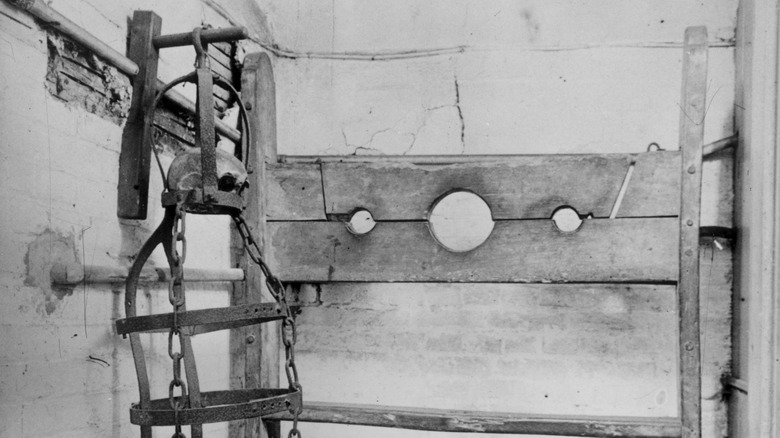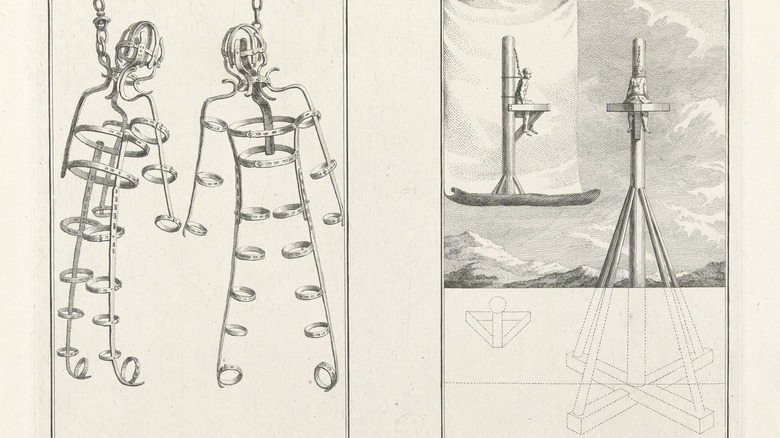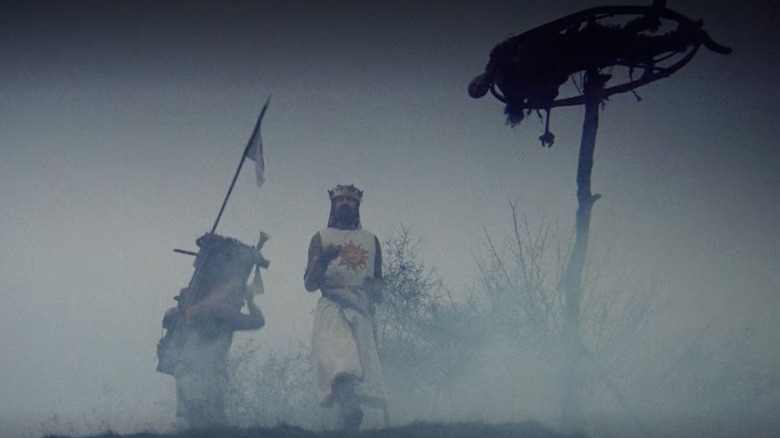The Dark History Of Death By Gibbet
Fans of the legendary comedy "Monty Python and the Holy Grail," 80's fantasy gem "Willow," or countless other films set in medieval times, will easily recall one of the more common sights in such tales: skeletons encased in cages dangling in the air from poles. Maybe outside of city walls as a warning, maybe in its streets, or at a crossroads in the countryside where a horse-backed traveler stops to stare before deciding which direction to take. Toss into the scene a crow pecking at the caged corpse's skull, sodden rags raveling its bones, and you've got a scene perfect even for J.R.R. Tolkien from "The Two Towers," when Théoden of Rohan says to Saruman the White, "When you hang from a gibbet at your window for the sport of your own crows, I will have peace with you and Orthanc."
And there's the word we need: "gibbet," the name of the wooden structure from which a cage hangs. And before you think that gibbeting — the torture and/or execution of criminals by public imprisonment in a gibbet-hung cage — is some creation of fiction adopted by Hollywood to illustrate how far we've come in the modern day since such barbaric practices, think again. As All That's Interesting states, gibbeting was indeed done as a warning to would-be societal ne'er-do-wells: such a fate awaits those who defy the laws of the land. Humiliation, exposure, the excruciation of immobility, dehydration, starvation, and the savagery of the beaks of carrion-eating birds.
A spectacle of rot and decay for the masses
"See there, see there! What yonder swings/And creaks 'mid whistling rain? — / Gibbet and steel, th' accursed wheel; / A murderer in his chain.—"
This excerpt, from Sir Walter Scott's 1807 poem "William and Helen" provides enough details to envision exactly how ghastly gibbeting was. As a form of criminal deterrence in Medieval, Renaissance, and Enlightenment Europe and England, it actually wasn't especially common, as gibbeting expert Sarah Tarlow, professor of archeology at the University of Leicester, says on Atlas Obscura. Sometimes criminals were locked in cages alive, sometimes they were already dead. Most often it was done for capital offenses but sometimes it was done for crimes like stealing mail, piracy, and smuggling, per All That's Interesting.
You can imagine what it looked and smelled like if a gibbet happened to be placed near your home, as was sometimes the case. The cage creaking in the night, blown by the wind that carried the moans and shrieks of those not yet dead. Bodies weren't removed from gibbets when the criminal died; they were left there for years to rot and desiccate and yes, be pecked by birds.
This is why gibbeting, wielded as a cruel tool of law enforcement to prevent criminal activity, was a massive public event. Even the mere act of erecting the gibbet, before its cage was fastening, "attracted big, jubilant crowds, sometimes in the tens of thousands."
A bespoke torture device forged by blacksmiths per criminal
As Atlas Obscura says, gibbeting was "engineered for maximum horror." Blacksmiths built gibbets per criminal, and not like the cage in which Val Kilmer in "Willow" could lounge and kick back. When gibbets didn't force a criminal into a standing, immobile position, arms and legs locked in place, they were built with notches for nooses or adjustable bands for tightness. Gibbets were often built 30 feet or higher to prevent the public from messing with them, and one was studded with 12,000 nails to prevent it from being torn down. When a gibbet and its inhabitant decayed and fell out of use, its parts were sickeningly sold as souvenirs. One wooden post was carved into a tobacco bowl.
England reached its gibbeting peak in the 1740s. The 1752 Murder Act actually mandated the gibbeting of criminals, or their dissection, and places like Old "Parr" Lane in Oxfordshire became named after the famously gibbeted. Women weren't allowed to be gibbeted, as their corpses were typically needed for the medical trade. Nonetheless, gibbeting attracted men and women alike. Professor Tarlow of the University of Leicester, who personally visited England's remaining 16 gibbets, tells the story of a 16-year-old girl who once hosted a picnic at a gibbet. In what was possibly believed a poetically macabre murder gesture, she fed poisoned cake to her friend because her friend got a job instead of her. Sadism begat sadism. Gibbeting was formally abolished in 1834.


